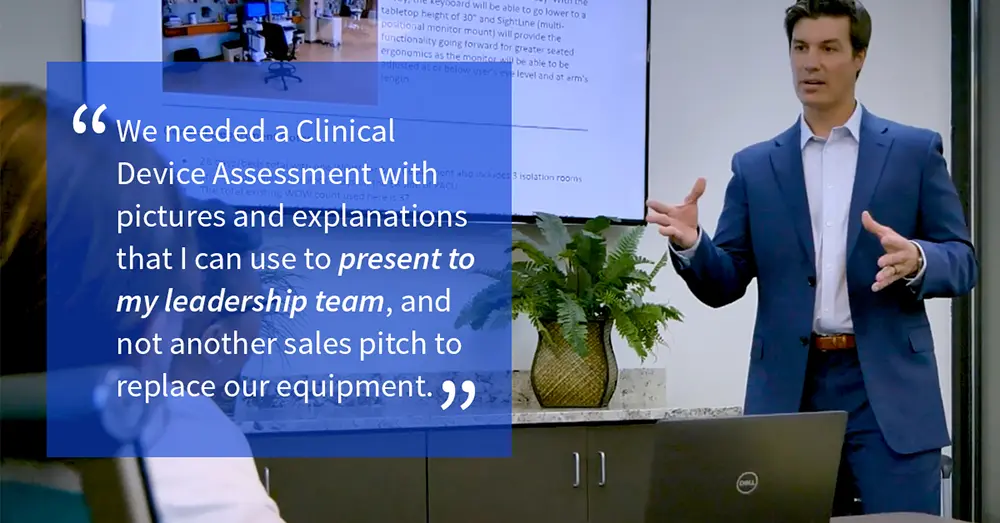
Lessons Learned from Covid-19: Why it’s Time for a Clinical Device Assessment
Now that the darkest days of the pandemic are behind us, hospitals are leveraging the lessons learned to shape their future – especially in the design and flexibility of technology. During Covid-19, hospitals quickly discovered how technology impacted their clinical teams’ efficiency and surge capacity.
Today, a post-covid review offers an opportunity to update your technology infrastructure to improve responsiveness to future crises and enhance day-to-day care.
Lower acuity patients are increasingly moving to outpatient settings and surgery centers, especially as retail clinics and virtual care services grow. The increased focus on acute care requires even more flexibility in handling acute surges from seasonal illnesses, disasters, and public health crises.

“Many facilities will require even greater space flexibility,” said Chad Beebe, deputy executive director of the AHA’s American Society for Health Care Engineering.
The study “Flexibility during the COVID-19 Pandemic Response,” highlighted the importance of modifying nursing workflows and multifunctional spaces to improve patient care.1
“A whole life-cycle approach to the healthcare facility operation is needed considering the rapid and constant alterations of healthcare environments resulting from transformations in medicine, technology, and organizational changes.”2
Enovate Medical has been working with some of the nation’s leading healthcare systems to capture the lessons they learned from their Covid-19 response. Some common themes we heard include:
- Failure to manage technology investments – One administrator said, “We have no process to manage our investment in technology.” She recognized the mismatch between the millions invested in their EHR platform and the lack of oversight for integrating that technology into the physical clinical workflow. She discovered that if the devices are not used effectively, the EHR strategy breaks down.
- Documentation at the point of care – There is no longer a clinical or technical rationale for documenting away from the bedside. Lightweight, mobile, cordless workstations bring EHR charting to the point of care. One executive noted, “We need to take a business assessment based on the volume of clinical users impacted.” She recognized that her hospital was behind the curve in modernizing technology.
- Need for enterprise-level assessments – Another administrator recognized that “there is no corporate owner for our workstations; it is at a department level.” This underscores the lesson learned that improving documentation workflows requires a system-wide assessment.
- Leadership must be educated – Administrators are not workflow experts nor are they trained to recognize the clinical and financial impact of nursing workflows. One respondent explained, “We needed a Clinical Device Assessment with pictures and explanations that I can use to present to my leadership team, and not another sales pitch to replace our equipment.”
What is a Clinical Workflow?
At one level, a workflow is defined by a nurse’s steps from patient to patient during her day. Her clinical specialty, medication distribution model, and room and floor layout also shape a workflow. One workflow might require mobile workstations, another, fixed units, and a third, a mix of different units and configurations.
Clinical Device Assessment: How it Works
Enovate Medical’s Clinical Device Assessment optimizes this mix to maximize the effectiveness and flexibility of your point-of-care technology.

The Clinical Device Assessment begins with a short meeting with the hospital IT manager and clinical informatics leader. Next, we walk each department to interview department directors and discover their challenges, preferences, and desired outcomes. We study the existing documentation technology, devices used, and types of workstations. We chart the number of rooms, staffing levels, nurse-to-patient ratio, and medication delivery protocols. We also talk to individual clinicians to hear their concerns.
After we create a graphic report, we review the findings with your team to discuss opportunities to improve workflow efficiency. We create an in-depth proposal for point-of-care solutions, software, and service programs to maximize your equipment investment.
Take the next step
No matter where you are in the buying cycle, a clinical device assessment can provide valuable insights into your clinical workflows. Enovate Medical can help you determine which solutions best support your clinical workflows, crisis responsiveness, and facility design.
Contact one of our team members to start your clinical device assessment today.
- https://www.ncbi.nlm.nih.gov/pmc/articles/PMC8583089/#B8-ijerph-18-11478
- Mauri M. The Future of the Hospital and the Structures of the NHS. TECHNE J. Technol. Arch. Environ. 2015;1:27–34. doi: 10.13128/Techne-16100.


